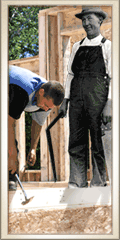|
|||
|
Now Over 25,000 Categorized Links! Family Census Data Directory |
|
|||
|
Now Over 25,000 Categorized Links! Family Census Data Directory |
|
|

|
1790 CensusGo to available databases for 1790The 1790 census was begun on 2 August 1790. The marshals were expected to finish the census within nine months of the Census Day—by 1 May 1791. Although most of the returns were in long before the deadline, Congress had to extend the count until 1 March 1792. By that time some people probably were counted who had not been born or present in 1790. Questions Asked in the 1790 Census Name of family head; number of free white males of sixteen years and older; number of free white males under sixteen; number of free white females; number of slaves; number of other persons; and sometimes town or district of residence. The 1790 census instructed the marshals to identify, by age brackets, free white males sixteen years of age or older and those under sixteen. It was designed to determine the country’s industrial and military capabilities. Additionally, the first census was to count the number of free white females; all other free persons regardless of race or gender; and slaves. A twenty-dollar fine, to be split between the marshals’ assistants and the government, would be levied against anyone who refused to answer the enumerator’s questions. Other Significant Facts about the 1790 Census The Constitution called for a census of all "Persons . . . excluding Indians not taxed" for the purpose of apportioning seats in the House of Representatives and assessing direct federal taxes. The "Indians not taxed" were those not living in the settled areas. In later years, Native Americans everywhere were considered part of the total population, but not all were included in the apportionment figures until 1940. The government did not provide printed forms or even paper until 1830. It was up to each assistant to copy his census return on whatever paper he could find and post it in two public places in his assigned area. Those who saw and could read them were supposed to check for discrepancies or omissions. The highest pay rate, two cents per person, barely covered expenses, especially where settlers were scattered and living in places that were difficult to find or access. The jurisdictions of the thirteen original states stretched over an area of seventeen present-day states. Census schedules survive for only two-thirds of those states. The surviving schedules were indexed by state and published by the Bureau of the Census in the early 1900s. Bureau of the Census, Heads of Families at the First Census of the United States Taken in the Year 1790, 12 vols. (Washington, D.C.: Government Printing Office, 1908), can be found in most research libraries; it has been reprinted by various publishers over the years. Both the original and printed 1790 census schedules are available on microfilm for Connecticut, Maine (then part of Massachusetts), Maryland, Massachusetts, New Hampshire, New York, North Carolina, Pennsylvania, Rhode Island, South Carolina, and Vermont. The schedules for Delaware, Georgia, Kentucky, New Jersey, Tennessee, and Virginia were burned during the War of 1812 (there are substitutes for most of these). Published and microfilmed 1790 schedules for Virginia were reconstructed from state enumerations and tax lists. Research Tips for the 1790 Census Because of the availability of the printed 1790 census schedules, researchers tend to overlook the importance of consulting the original schedules, which are readily available on microfilm. As in most cases, the researcher who relies on printed transcripts may miss important information and clues found only in the original version. The 1790 census records are useful for identifying the locality to be searched for other types of records for a named individual. The 1790 census will, in most cases, help distinguish the target family from others of the same name; identify immediate neighbors who may be related; identify slaveholders; and spot spelling variations of surnames. Free men “of color” are listed as heads of household by name. Slaves appear in age groupings by name of owner. By combining those age groupings with probate inventories and tax list data, it is sometimes possible to determine names of other family members and the birth order of those individuals. Go to available databases for 1790
|
|